
William Ismay Spooner Hartley was born in Ossett on 18th May 1891 and baptised at Holy Trinity Church on 13th July 1891. William was the second son of Haworth born William Robert Hartley (1855-1942) and Sarah Alice Ismay Spooner (1854-1937) of Wakefield who married at The Church of Saint Thomas, Hull, on 24th April 1888.
William Robert Hartley, a former tin and iron plater, was ordained Deacon in 1885, and priest in the Durham Diocese in 1886. His training at Hatfield Hall Durham led to his qualification of a B.A. in 1887 and an M.A. in 1890. He was duly ordained to the curacy of Felling – on –Tyne, Gateshead, which he held for three years until 1887.
By January 1888 he had been appointed to the Stipendiary Curacy of the combined parish of Ossett- cum-Gawthorpe under the Reverend Canon W. Fountaine Addison. It was recorded that William Robert received the Bishop of Ripon’s licence to the appointment and that he had “entered upon his duties”
William Robert and Sarah Alice Ismay Hartley had four sons from their marriage and all were to serve in The Great War 1914-1918. Their first born was Winchcombe Henry Howard Hartley (1889- 1942) born in Ossett on 20th October 1889 and baptised there on November 28th 1889 at Holy Trinity Church
The third son, George Albany Brigg Hartley (1895-1923), was born in Stanhope, County Durham in 1895 and baptised there on 8th March of the same year. The fourth and youngest child, John Arthur James Hartley(1898-1974), was born on 5th July 1898 and also baptised in Stanhope. John Arthur James took his first name from his paternal grandfather and his third name from his uncle.
Whilst most focus is given to William Ismay Spooner Hartley there follows the biographies of these four young brothers who served their country in its greatest hour of need.
Three of the four brothers were to survive the Great War but sadly 2nd Lieutenant William Ismay Spooner Hartley was killed in action, aged 25 years, on 1st July 1916. This fateful day was the first day of the Battle of the Somme, in northern France. It was to be the bloodiest day in the history of the British Army and one of the most infamous days of World War One. On that day the British forces suffered 57,470 casualties, including 19,240 fatalities. The British gained just three square miles of territory.
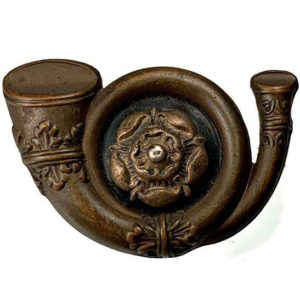 2nd Lieutenant William Ismay Spooner Hartley, King’s Own Yorkshire Light Infantry, 8th Bn.
2nd Lieutenant William Ismay Spooner Hartley, King’s Own Yorkshire Light Infantry, 8th Bn.
William studied at Queen’s College, Oxford from 1910, when he was 19 years of age. Having gained a B.A. in 1915 he moved to King William’s College, Castletown, Isle of Man, as Master of the Lower Fourth. He left at Christmas 1915 to join up, having previously applied twice but each time he was rejected because of poor eyesight.
King’s Own Yorkshire Light Infantry Cap Badge (opposite) He may have been attracted to the College because of its long and proud military history. Its Officers’ Training Corps (OTC) was the only contingent to see active service in WWI, guarding P.O.W.’s at Douglas and provided the first recruits from the Island. Established in 1911 the OTC comprised two platoons and provided basic military training.
On 21st January 1916 he was appointed temporary second Lieutenant (on probation) in the 8th battalion King’s Own Yorkshire Light Infantry Regiment (KOYLI). It is probable that he embarked for France shortly afterwards and joined up with the 8th Battalion KOYLI who had moved to France in August 1915. William was posthumously awarded the British and Victory medals for service overseas in a theatre of war. He was not awarded the 1914-15 Star indicating that he did not serve overseas until on or after 1st January 1916.
The 8th (Service) Battalion KOYLI was formed at Pontefract in September 1914 and came under the command of the 70th Brigade in 23rd Division. The unit moved to Frensham and then to Aldershot in December 1914 moving on to Hythe, Kent, in February 1915 and Bordon, Hampshire in May 1915. In August 1915, along with other regiments in the 23rd Division, 8th KOYLI landed at Boulogne. In October the 70th Brigade transferred from the 23rd Division to the 8th Division who had been stationed in France since November 1914 but William would not have joined them overseas until 1916. The 70th Brigade, including 8th KOYLI would return to the 23rd Division on 17 July 1916.
The Regimental War Diary of the 8th Battalion KOYLI records its activity in August-December 1915 but the January – mid June 1916 War Diary has not survived. However it re-commences in mid June 1916 as all units trained in readiness for the British attack in an offensive which came to be known as the Battle of the Somme. The 8th KOYLI were located at Henencourt Wood by 19th June 1916 and on that day six officers joined number 5 camp for duty; the following day a further officer joined. Perhaps William was one of those young inexperienced officers rushed into the fray in readiness for the imminent attack on the enemy.
The village of Hénencourt was behind the British lines in 1916 during the Battle of the Somme and was a rest area for troops going to and from the trenches. The huge 18th Century chateau which stood in the village was used by various Corps commanders and the woods surrounding it contained a large army camp which at that time was home to the 70th Brigade. On the final days of June 1916 8th KOYLI occupied trenches in front of Authuille Woood
This would be William’s first and last encounter with the enemy and no amount of training could ready him for what was to take place. As a second lieutenant he would have been placed in command of all-purpose ground combat units and his primary task would be to lead infantry soldiers into combat. The first day of the Battle of the Somme was William’s baptism of fire. Literally.
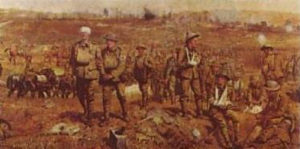 Battle of The Somme July 1916
Battle of The Somme July 1916
In spite of the rallying calls and assertions by senior officers the day didn’t go well. The German guns, including machine guns, had fatally favourably positions and were too well posted to give the Division much chance of success. At 7.27a.m.under the British artillery barrage, the leading companies went over the top. The first two waves that left the trenches reached the German lines with only slight loss. The succeeding waves lost heavily in No Man’s Land from the machine gun fire on both flanks and the battalion lost 50% of their strength before they arrived at the German front line.
After passing over the first enemy trenches severe fighting took place to secure the second line. Some men reached the third line but both lines were under heavy fire of machine guns which gave few chances for close quarters with the bayonet. By 10 a.m. the whole of the 70th Brigade was across No Man’s Land fighting in the German front and supply lines. At mid day orders were issued to renew the attack at 5 p.m. but the order was countermanded at 3.30 p.m. and the remnants of the 8th retired to occupy the old front line trenches. In the end the objectives couldn’t be achieved due to the losses that were incurred.
The battalion had gone into action in the morning with twenty five officers, one medical officer and 659 other ranks. Of these numbers only the medical officer and 110 other ranks reported present after the battle. Very few of the officers reached the second line of the German trenches. Over the flat rising ground, with few places to take cover, the enemy machine guns mowed down wave after wave of British soldiers. On 16th July 1916 what was left of the 70th Brigade rejoined the 23rd Division.
The casualties in the 8th KOYLI during the day amounted to 10 officers killed, 14 wounded and one missing; of other ranks 35 were returned killed, 122 missing and 365 wounded reached the dressing – stations.
One of the names of those 10 officers killed on 1st July 1916 was 2nd Lieutenant W. I.S. Hartley, aged 25 years.William is remembered in the King William’s College Book of Remembrance (1914-1918), Castletown, Isle Of Man and on the King William’s Roll Of Honour (1914-1918), Douglas, Isle of Man.
Ossett born 2nd Lieutenant William Ismay Spooner Hartley lost his life on 1st July 1916. His name will be engraved at the Ossett War Memorial alongside his Ossett Fallen brothers and sisters in arms. In this way he will be remembered in death as he was known during his life; by his name.
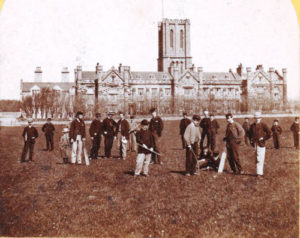 King William’s College Isle of Man in the 19th Century
King William’s College Isle of Man in the 19th Century
William is buried at grave IV. H. 1., Blighty Valley Cemetery, Authuille Wood. Blighty Valley was the name given by the Army to the lower part of the deep valley running down South-Westward through Authuile Wood to join the river between Authuile and Aveluy; a railway was carried along it soon after July, 1916, and it was for some time an important (though inevitably a dangerous) route. The upper part of the valley was called Nab Valley. Blighty Valley Cemetery is almost at the mouth of the valley, a little way up its northern bank. It is partly in either commune.
Blighty Valley Cemetery was begun early in July 1916, at the beginning of the Battle of the Somme, and used until the following November. At the Armistice it contained 212 graves, but was then greatly enlarged when 784 graves were brought in from the battlefields and small cemeteries to the east. Most of these concentrated graves were of men who died on 1 July 1916.
Postscript. After the war, William’s father, the Reverend William Robert Hartley sought and was granted permission from the Commonwealth War Graves Commission to bring back from France the wooden cross that was originally placed on his son’s grave. Reverend Hartley had the cross placed in the Chancel of St Peter’s Church, Barnburgh, Doncaster (of which he was Rector). He positioned the cross over the seat in the choir stalls where William used to sit before joining the forces. The following photographs are courtesy of King William’s College, Castletown, Isle Of Man.
Researched and written by Alan Howe.
December 2021
Our thanks to the Imperial War Museum (Lives Of The First World War) for bringing William Ismay Spooner Hartley to our attention in early October 2021 whilst we were checking the names of the Ossett Fallen added to the IWM “Lives” site which was archived several years ago.
Photographs of Blighty Valley, Authuille Wood Cemetery and the wooden Cross which was once on William Ismay Spooner Hartley’s grave in France. The lower photographs show the Cross at St. Peter’s Church Barnburgh near Doncaster.
After the war, William’s father, Reverend William Robert Hartley got permission from CWGC to bring back from France the wooden cross that was originally placed on his son’s foreign grave to St Peter’s Church, Barnburgh. He had the cross placed in the Chancel over the seat in the choir stalls where William used to sit before joining the forces.
Winchcombe Henry Howard Hartley, Signaller 130597 Royal Fusiliers / Royal Field Artillery
Winchcombe Henry Howard Hartley, born and baptised in Ossett in 1889, was the eldest of four sons born to William Robert Hartley and his wife Sarah Alice Ismay Spooner Hartley. In 1888 William Robert was appointed the curate of Ossett-cum-Gawthorpe and he served there until 1892. All four sons went to war, but only three survived. Their second son, William Ismay Spooner Hartley, was killed in action on 1st July 1916, the first day of the Battle of The Somme.
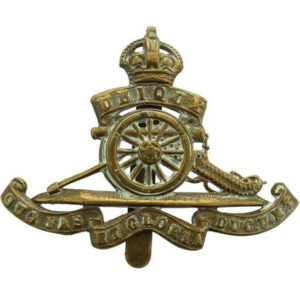 In his civilian life Winchcombe was a bank cashier. His army service record has not survived with the result that the date of his enlistment and embarkation is uncertain. He was awarded the British and Victory Medals for service in an overseas theatre of war but he did not qualify for the award of the 1914-15 Star which tells us that he did not serve overseas until on or later than 1st January 1916. He may have served in the Royal Fusiliers before joining the Royal Field Artillery (RFA). None of his surviving army records tell of his brigade or unit which also makes it impossible to determine where he served when overseas. Royal Field Artillery cap badge opposite.
In his civilian life Winchcombe was a bank cashier. His army service record has not survived with the result that the date of his enlistment and embarkation is uncertain. He was awarded the British and Victory Medals for service in an overseas theatre of war but he did not qualify for the award of the 1914-15 Star which tells us that he did not serve overseas until on or later than 1st January 1916. He may have served in the Royal Fusiliers before joining the Royal Field Artillery (RFA). None of his surviving army records tell of his brigade or unit which also makes it impossible to determine where he served when overseas. Royal Field Artillery cap badge opposite.
The Royal Field Artillery (RFA) was organised into brigades and was the most numerous arm of the British artillery. The horse-drawn RFA was responsible for the medium calibre guns and howitzers deployed close to the front line and consequently it needed to be reasonably mobile. During the war, the army deployed trench mortars, a whole new form of artillery developed to meet the unusual conditions of war on the Western Front. The lighter mortars were manned by the regiments of infantry, while the RFA provided the manpower for the heavier mortars.
During Winchcombe’s army service he suffered a disability resulting in his discharge from the Army on 5th June 1919. In August 1920 he was awarded a pension, payable for a year, with a similar allowance for his wife, Mabel (nee Croft)whom he married in the Ripon area in 1917. Their only child, William Howard Hartley was born in 1918. Winchcombe and his family appear to have lived at Barnburgh Rectory between 1902 and 1942. Sadly his father, the reverend William Robert died at The Rectory on 12th June 1942, aged 86 years. Winchcombe, aged 52, died five weeks later on 18th July 1942. His wife, Mabel, died in 1951 and their son, William Howard Hartley lived to be 97 years old and he died in 2015.
Winchcombe Henry Howard Hartley of The Rectory Barnsburgh was buried at St. Peter’s Church Barnsburgh on 21st July 1942 just five weeks after his father was also buried at St. Peter’s.
The unusual first name, Winchcombe, may suggest a link with the eponymous medieval market town in the Cotswold hills of Gloucestershire. That may be the case but then another Winchcombe Henry Howard Hartley, a vicar, turns up in Berkshire in 1819 after matriculating at Merton College in 1806, aged 18 years . He died in 1832.
Then an earlier Winchcombe Henry Hartley also of Merton College, aged 17, in 1790, B.A., in 1794, M.A. 1797 a barrister at law, Lincoln’s Inn. A third Winchcombe Henry Hartley this time at Corpus Christi College born in 1740, M.P. Berkshire 1776-84; died 1794. Closer to home is Winchcombe Henry Savile of Tickhill, Merton College matriculated 1819, aged 18. There’s another story here…but that’s for another day.
George Albany Brigg Hartley, Acting Sergeant 022749, Royal Army Ordnance Corps.
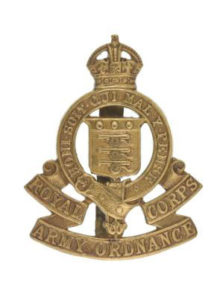 George, the third son of William Robert and Sarah Alice Ismay Spooner Hartley, was born and baptised in 1895 at Stanhope, County Durham following the move by his father, reverend William Robert Hartley who was appointed Vicar of Rookhope in 1892 after five years at Ossett as curate. George took his name from his uncle.
George, the third son of William Robert and Sarah Alice Ismay Spooner Hartley, was born and baptised in 1895 at Stanhope, County Durham following the move by his father, reverend William Robert Hartley who was appointed Vicar of Rookhope in 1892 after five years at Ossett as curate. George took his name from his uncle.
George was 19 years old when war was declared in August 1914 and he was old enough to serve overseas. His army service record has not survived with the result that the date of his enlistment and embarkation is uncertain. However it is known that he joined the Royal Army Ordnance Corps (Cap Badge opposite).
The Royal Army Ordnance Corps (RAOC) was a supply and repair corps of the British Army. In the supply area it had responsibility for weapons, armoured vehicles and other military equipment, ammunition and clothing and certain minor functions such as laundry, mobile baths and photography. The RAOC was also responsible for a major element of the repair of Army equipment.
George Albany Brigg Hartley was awarded the British and Victory Medals for service in an overseas theatre of war but he did not qualify for the award of the 1914-15 Star which tells us that he did not serve overseas until on or later than 1st January 1916. It is likely therefore that he enlisted and trained during 1915, embarking no sooner than 1916. None of his surviving army records tell of his battalion or unit which also makes it impossible to determine where he served when overseas.At the end of his war, George was placed on Z Reserve on 10th October 1919 which suggests that he was demobilised that month even though his address in 1918 was Boroughbridge Road, Knaresborough.
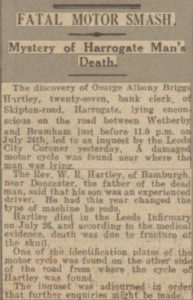 Sadly in July 1923 George Albany Brigg Hartley, a bank clerk of Skipton Road, Harrogate died aged 27 years following a motor cycle accident on the Great North Road between Wetherby and Bramham on 24th July 1923 which resulted in his death at Leeds Infirmary two days later. The Leeds Mercury of 28th July 1928 carried news of the accident.
Sadly in July 1923 George Albany Brigg Hartley, a bank clerk of Skipton Road, Harrogate died aged 27 years following a motor cycle accident on the Great North Road between Wetherby and Bramham on 24th July 1923 which resulted in his death at Leeds Infirmary two days later. The Leeds Mercury of 28th July 1928 carried news of the accident.
No other vehicle was involved and a month later in August 1923 the Inquest found a verdict of accidental death.
Reverend William Robert and his wife Sarah Alice Hartley had lost two of their four sons in tragic circumstances between 1st July 1916 and 26th July 1923.
John Arthur James Hartley, Gunner 241380 Royal Field Artillery
The fourth and youngest child of the reverend William Robert and Sarah Alice Ismay Hartley, John Arthur James Hartley (1898-1974), was born on 5th July 1898 and baptised in Stanhope, County Durham. John Arthur James took his first name from his paternal grandfather and his third name from his uncle.
Royal Field Artillery cap badge opposite.
John Arthur James was 19 years of age in July 1917 which was the
earliest date that he should have served overseas. His army service record has not survived with the result that the date of his enlistment and embarkation is uncertain.
He was awarded the British and Victory Medals for service in an overseas theatre of war but he did not qualify for the award of the 1914-15 Star which tells us that he did not serve overseas until on or later than 1st January 1916. None of his surviving army records tell of his brigade or unit which also makes it impossible to determine where he served when overseas.
The Royal Field Artillery (RFA) was the most numerous arm of the British artillery. The horse-drawn RFA was responsible for the medium calibre guns and howitzers deployed close to the front line and was reasonably mobile. It was organised into brigades. During the war, the army (through technical development and joint working) was also able to deploy trench mortars, a whole new form of artillery developed to meet the unusual conditions of war on the Western Front. The lighter mortars were manned by the regiments of infantry, while the RFA provided the manpower for the heavier mortars.
John Arthur was discharged from the Army on the grounds of disability (deafness) on 14th February 1919. His addresses were given as Doncaster (Barnburgh Rectory) and Oxford confirming that he was, or intended to be, at Queen’s College.
As a young man he was educated at King Edward VII School, Sheffield and later at Queen’s College, Oxford. On 18th December 1932 John Arthur James Hartley M.A., Queen’s College and Ripon Hall Oxford, was ordained Deacon by the Bishop of Sheffield and took the curacy at Barnburgh, St. Peter’s where his father was Rector.
John Arthur James Hartley died at 8,Whin Bank, Scarborough on 24th March 1974 aged 74 years . His cremated remains were buried at Barnburgh Church on 6th April 1974, aged 74 years.
Biographies of William Robert and his wife Sarah Alice Hartley (nee Ismay Spooner) can be seen on the Ossett Heritage website at this Here